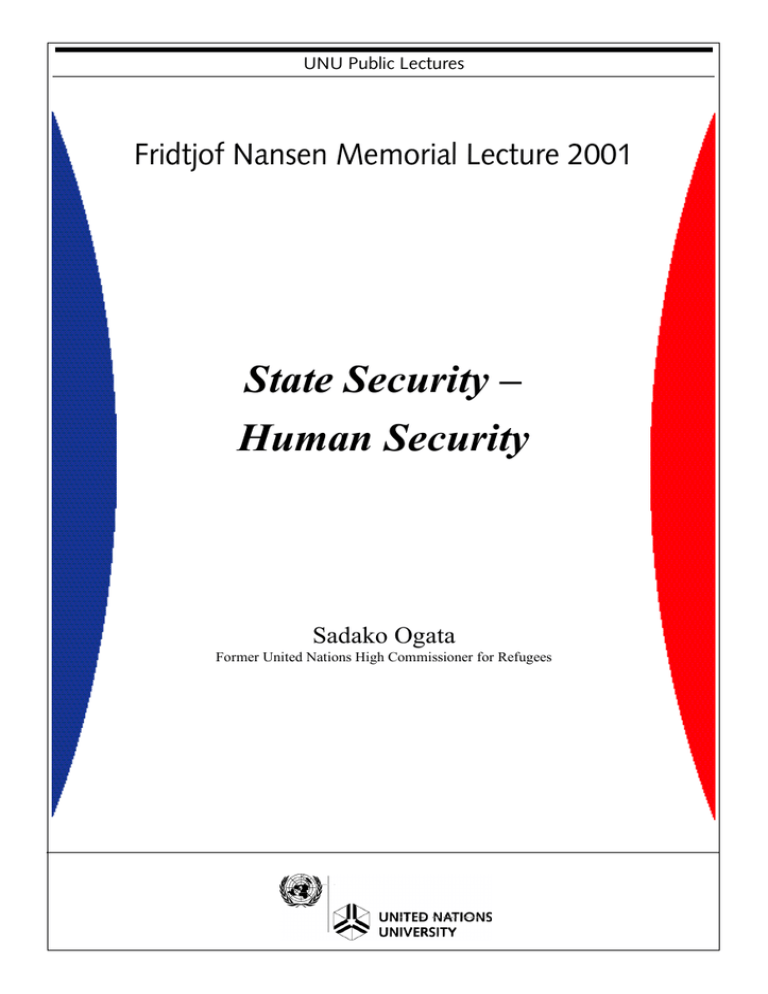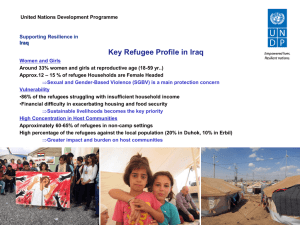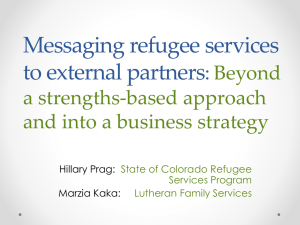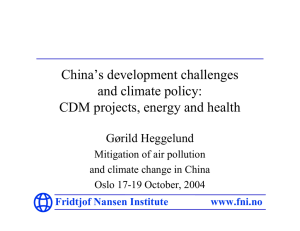State Security – Human Security Fridtjof Nansen Memorial Lecture 2001 Sadako Ogata
advertisement

UNU Public Lectures Fridtjof Nansen Memorial Lecture 2001 State Security – Human Security Sadako Ogata Former United Nations High Commissioner for Refugees UNU Public Lectures State Security – Human Security Sadako Ogata Former United Nations High Commissioner for Refugees Fridtjof Nansen Memorial Lecture 2001 UN House, Tokyo, 12 December 2001 Foreword It gives me great pleasure to introduce this Nansen Memorial Lecture lecture on State Security – Human Security by Sadako Ogata. The topic of her lecture could not be more timely or important. It is clear that in particular the work done by the parts of the United Nations system that directly address humanitarian emergencies and crises, such as the United Nations High Commissioner for Refugees, played an important role in the decision to award this 100th Nobel Peace Prize to the United Nations as an organization and Kofi Annan personally. As was stated by the Nobel Committee when the award was announced: “Today, the organization [the UN] is at the forefront of efforts to achieve peace and security in the world, and of the international mobilization aimed at meeting the world's economic, social and environmental challenges ... the Norwegian Nobel Committee wishes in its centenary year to proclaim that the only negotiable route to global peace and cooperation goes by way of the United Nations.” I am therefore very happy that our Norwegian partners chose an expert “par excellence” for this special Nansen Lecture. The topic of human security is one of central importance to the United Nations University (UNU). We have been involved in academic work on Human Security for quite some time. In December 1999 we organized jointly with the Japan Institute of International Affairs a major conference titled “In Quest of Human Security.” The Strategic Plan, 2000 of UNU, designed at that time, focuses our work on “Advancing Knowledge for Human Security and Development.” Many of our activities now try to address sources of human insecurity: social, economic, cultural, environmental, political; leading to direct threats to human security: violent conflicts, natural disasters, discrimination on spurious grounds, hunger, torture, imprisonment without a free and fair trial. 2 The lecture by Ms. Ogata certainly gives us a greater understanding of the issues on the ground. We hope that it can help to encourage people to do more to promote human security around the world. Hans van Ginkel Rector United Nations University 3 Introductory Remarks I would like to thank the United Nations University and its Rector, Dr. Hans van Ginkel, for again accepting so generously to host the 2001 Fridtjof Nansen Memorial Lecture. The Fridtjof Nansen Memorial Lecture is held annually in a number of capitals around the world to commemorate the birth of the Norwegian explorer, scientist, humanist and Nobel laureate Fridtjof Nansen. Born in 1861, Fridtjof Nansen was a great humanist and is perhaps best known for his famine relief programme for Russia in 1921–23 in the wake of the Russian revolution, and initiator of the Nansen Passport for refugees. Fridtjof Nansen received the Nobel Peace Prize in 1922 for his achievements as High Commissioner for Refugees of the League of Nations. In 1938, the Nansen International Office for refugees in Geneva, which Nansen established, was awarded the Nobel Peace Prize. This year’s Fridtjof Nansen Memorial Lecture is given by Mrs. Sadako Ogata, former United Nations High Commissioner for Refugees. The topic of her Lecture is “State Security – Human Security,” a topic particularly relevant to the world situation today. Mrs. Sadako Ogata took office as the United Nations High Commissioner for Refugees in February 1991. She served in this position until 2000, having been re-elected twice. Mrs. Ogata has had a long and distinguished career in issues related to human rights and international relations. She has served on many government advisory councils and on boards of academic associations and foundations. She is presently cochairing the Human Security Commission and a scholar in residence at a private institution in New York. In November 2001 she was appointed Prime Minister Koizumi’s special envoy for the reconstruction of Afghanistan. In a world where traditional wars between countries in many ways have been replaced by wars within countries, organizations in the United Nations family are more important than ever. It is in recognition of this very fact that the Nobel Peace Prize Committee in Oslo awarded this year’s 4 Nobel Peace Prize to the United Nations and Secretary-General Kofi Annan. The Nobel Peace Prize celebrates the 100th anniversary in 2001. By awarding the United Nations and Kofi Annan the Nobel Peace Prize on this very occasion underlines the importance of this world body. There are few more suited to deliver this year’s Fridtjof Nansen Memorial Lecture than Mrs. Ogata, combining knowledge of the humanitarian achievements of Nansen and the global challenges facing humankind today. It is a special privilege for me, as Norwegian ambassador to Japan, to introduce this booklet of Mrs. Sadako Ogata’s 2001 Fridtjof Nansen Memorial Lecture. Odd Fosseidbråten Ambassador of Norway to Japan 5 State Security – Human Security Sadako Ogata Former United Nations High Commissioner for Refugees Fridtjof Nansen Memorial Lecture 2001 UN House, Tokyo, 12 December 2001 It is a great pleasure to be given the opportunity to give the Fridtjof Nansen Memorial Lecture in Tokyo as a former UN High Commissioner for Refugees and also as a non-Norwegian citizen. Fridtjof Nansen was appointed the first High Commissioner for Refugees under the League of Nations in l92l, exactly 80 years ago. I would like to offer my tribute to the achievements of the “founding father” who led international efforts to provide protection and assistance to victims of war, conflict and persecution. Many of the problems and dilemmas with which Nansen had to struggle in the l920s are still with us today, but so are his achievements. Nansen organized the repatriation of more than 400,000 prisoners of war from Russia and provided relief aid to the starving in Russia. His ability to overcome bureaucratic inertia and red tape, and mobilize the voluntary relief sector – in particular, the International Red Cross – was legendary. The introduction of the Nansen Passport, a travel document for refugees and stateless persons, helped repatriate and resettle numerous refugees. Out of frustration over the indifferent and amoral attitude of the delegates to the League of Nations, he argued that alleviating human suffering is indeed a matter of state, not simply charity. Very often, I thought of his reference to refugee protection as “real politik,” as I had to cope with massive and intractable refugee situations through the l990s. Starting with the Kurdish refugee outflow in northern Iraq, followed by the dissolution of the Federal State of Yugoslavia which produced millions of refugees and internally displaced persons, then the 7 8 UNU PUBLIC LECTURES civil conflicts and genocide in the Great Lakes region in Africa and the continuing tragedies of the Afghan people after years of foreign occupation, there was not a single humanitarian case that could be solved without addressing the underlying political, social and economic causes. In following the examples set by Fridtjof Nansen, one way UNHCR tried to spread his messages was through the awarding of the Nansen Medal to those who personified the spirit of his deeds. As you know, the Nansen Committee was set up consisting of a member of the Nansen family, the Norwegian Government and a few others, chaired by the High Commissioner, to select and recognize the most worthy individual or organization. Over the years, the Committee has been able to recognize hidden as well as well-known contributors. At the 50th anniversary celebration of the founding of the Office of the United Nations High Commissioner for Refugees last December, it was my special privilege to present the highest award to the United Nations Volunteers who had served as the corps of outstanding partners in all fronts of refugee operations. In addition, we recognized outstanding refugee individuals from four continents of the globe. In the last ten years, two special awards were given to our NGO partners, the Medicins Sans Frontieres in l993 and Handicap International in l995. Individuals include Dr. Paul Weis, Dr. R. Weiszacker, Mrs. Graca Machel, Sister Joannes Klas, and Mr. Mustafa Dzemilev, all of whom represent different and special approaches to protecting refugees and solving their problems. In carrying out my responsibility as High Commissioner for Refugees, my concern was always centred on providing security to the refugees and gaining them opportunities to lead happier lives. Today, I wish to address the question of security of refugees in the larger context of “human security.” In this connection, I wish to pay tribute to the Norwegian Government for having taken an early initiative to examine security issues from a human perspective. It was, in fact, in Bergen at the Ministerial Meeting on Human Security Issues in May l999 that I addressed for the first time refugee protection from a “human security” standpoint. I am also pleased to note that Norway has actively pursued humanitarian and human agendas in the course of Security Council debate and decision-making. Traditionally, security threats were assumed to emanate from external sources. Security issues were therefore examined in the context of “state security,” i.e., the protection of the state, its boundaries, people, institutions State Security – Human Security 9 and values from external attacks. Territorial boundaries were inviolable, and external interference in internal affairs of sovereign states was prohibited. States set up powerful military systems to defend themselves. People were considered to be assured of their security through the protection extended by the state. The end of the Cold War brought the demise of communist dictatorships. Autocratic military regimes with tight internal security control opened the way to freer and more democratic systems. The fall of the Berlin Wall stood as the great divide that symbolized the arrival of a new world order. The period that followed, however, betrayed our optimism. Without external aggression or threat to territorial integrity or state sovereignty, people were caught by eruptions of violence within countries. While inter-state conflicts and tensions have not totally been contained, the sources of danger have largely turned internal, caused by historic rivalries and animosities among different ethnic, religious and social groups. The victims of these conflicts were primarily, if not almost exclusively, civilians – ordinary men and women. The state as protector of people frequently came to play ineffective if not adversarial roles. Maintaining or developing peaceful relations among opposing individuals, groups or communities became a central security issue. Today, a new source of threat has manifested itself in the form of international terrorism, as proven by the devastating attacks that took place on September 11 against the World Trade Center in New York and the Pentagon. Terrorism as such as a tool of the weak against the strong has always existed. The end of the Cold War signified the decline of statesponsored terrorism. While the leftist terrorist groups showed signs of considerable weakening, ethnic separatist organizations began resorting to terrorist means to pursue autonomy and/or independence. Religiouslybased groups, identified both with major religions and with new cults, emerged on the scene. Of notable significance was the growing impact of terrorists linked to Islam, particularly among those who gained skills and experiences in the course of their involvement in the mujaheddin war against the Soviets and the Soviet-sponsored regime in Afghanistan. The danger of a failed or weakened state providing hotbeds for terrorism became a proven reality in the Afghan case. Globalization has added further complications to security management by the state or for the people. While creating wealth, opportunities for 10 UNU PUBLIC LECTURES work, and a better life for many, it has impacted adversely on some vulnerable strata of society. The extraordinary growth in the diffusion of information technology, the advancement in transportation and communication and the transfer of financial capital, all accelerate the movement of people. The distinction between desirable, lawful and safe movement of people, and dangerous, illegal and criminal movement becomes unfathomable. The number of asylum-seekers and migrants all over the world is growing by leaps and bounds. The life stories of the September 11th terrorists attest to the growing realities of opportunities as well as pitfalls in a rapidly globalizing world. States face difficult choices between resorting to more severe control over a wide range of civil life, or living with some danger as best you can. How do you reach a more discriminating consensus that assures the security and freedom of all concerned? It was during the transitional decade following the end of the cold war that I led the office of the United Nations High Commissioner for Refugees. My main operational challenge was to cope with the millions of people forced to flee from their homes, and find them desirable solutions. During this period dominated by internal conflicts, many crossed borders and became refugees eligible for international protection, but many more were internally displaced receiving no protection from their state. Many others were left to the mercy of violence and disorder as affected civilians. The mixture of refugees and internally displaced, as well as the rapidity and scale of human movement, were the special features of this decade. As far as the refugees were concerned, they moved quickly in large numbers not only when they fled, but also when they returned, as witnessed in Northern Iraq, in the Great Lakes region of Africa or in Kosovo. To me, the concept of “human security” presents a useful entry point to the central security issue of the day, i.e., the security of the people. It represents a paradigm shift from the traditional resort to the state as the provider of security. First of all, by focusing on the people who are the very victims of today’s security threats, you come closer to identifying their protective needs. Secondly, by examining the people with their diverging interests and relations with each other, you uncover the social, economic and political factors that promote or endanger their security. It is in search for new windows to meet the security challenges of today that the Commission on Human Security was established this spring under the joint State Security – Human Security 11 initiative of the United Nations and the Government of Japan. The Commission consists of competent and powerful individuals from various walks of life and parts of the world, who will be conferring in Tokyo in a few days. I have the honour to co-chair this Commission together with the Nobel Prize winner economist Amartya Sen. I trust and expect important inputs from the commissioners’ deliberations. I would like to elaborate a little further this afternoon on a few salient points that I have drawn from the limited but direct exposures to “human security” situations through working with refugees the last ten years. One observation that I wish to share with you as a starting point is the fact that existing organizational mandates and mechanisms draw heavily from state security assumptions. The United Nations Charter states its objective as the maintenance of “international peace and security,” and obliges all members to “take collective measures for the prevention and removal of threat to the peace, and for the suppression of acts of aggression or breach of the peace.” The Charter, however, specifically states that the organization is not authorized “to intervene in matters which are essentially within the domestic jurisdiction of the state.” At times when the sources of security problems derive largely from internal conflicts, and are varied in nature and in manifestations – not only political and military, but also social, economic and environmental – how have the United Nations or other inter-governmental organizations reacted? I would say that the record has been somewhat mixed. The Security Council has had to deal with many internal conflict situations with varying effectiveness. The fact that I was the first High Commissioner for Refugees ever to be invited to address the Security Council, and repeatedly so, shows the changing needs of the times, and also the ingenuity of the workings of the Security Council to resort to humanitarian concerns in coping with internal situations. However, when it comes to the means to protect people and solve their problems, I have found surprisingly few mechanisms that could be invoked. Whether in dhe Congo, Sierra Leone, Bosnia or Kosovo, when security deteriorated and people started to flee, humanitarian agencies were left to provide emergency assistance, or to negotiate with governments or de facto rulers for safe passage or open borders. By staying with the victims, humanitarian staff do provide limited security. But they cannot replace the local police or augment law enforcement capacity, nor can they serve as observer or peace-keeping forces dividing belligerents or demobilizing 12 UNU PUBLIC LECTURES combatants. Many times, I wished I had access to an emergency telephone number to call for quick support. The usefulness of a sub-regional or regional policing or peace-keeping force was a need that was never met during my time. An added problem was the non-availability of military means appropriate or proportional to the security needs to be addressed. I once heard former Swedish Prime Minister Carl Bildt say in the course of the Balkan War, that the world did not need missiles but crowd control systems. It is not for me to judge appropriate military measures, whether in Bosnia, Kosovo or Afghanistan. However, at times I could not help but wonder whether bombs dropped from 15,000 feet, or missiles launched from thousands of miles away, could resolve house-to-house conflicts between communities that had lived together, separate but intertwined, for hundred of years. The ongoing American military action in Afghanistan combines high-technology “safe” warfare with casualty-ridden ground force action of the kind that we have not witnessed in recent times. The objectives of the Afghan military action being specific individuals and groups as well as ground-based low-tech infantry, some reinstallation of traditional warfare has proven inevitable. The American military strategy reflects the fact that the terrorist attacks were understood to have threatened national security and interest, and has to be fought as all-out war. On the other hand, within Afghanistan, various ethnic groups and armed alliances have continued to fight, requiring solutions that take into account both protection of civilians and community reconciliation. Furthermore, the immediate emergency modes of protecting human beings in internal conflict situations and peace-building endeavours in the period immediately following the end of conflicts have also proven to be a very weak link in the international cooperation system. In the more localized conflicts that characterized the post-cold war period, civilians were not only the victims but also very often the targets of outright violence designed to displace or terrorize them away from their original homes. Moreover, conflicts frequently end without a winner, in some cases without a peace agreement. As a result, deeply divided communities face the reestablishment of their livelihood with people comprised of different ethnic, religious or regional origins who fought the war. The rehabilitation and reconstruction of Rwanda, Bosnia and Kosovo were challenges of the kind that required innovative thinking and new collaborative efforts. State Security – Human Security 13 Two attempts were made in this context. Organizationally speaking, the international community has two separate compartments, humanitarian and development, to respond to war-torn societies. However, the needs of these societies do not fall into two neat categories. The reality demands much more simultaneous relief, rehabilitation and reconstruction interventions. In January l999, James Wolfensohn, President of the World Bank, and myself called for a roundtable meeting at the Brookings Institution in Washington to look for more pro-active and creative approaches to rehabilitate and reconstruct post-conflict societies. Attempts were made with regard to Sierra Leone, Rwanda, East Timor and Kosovo. While not fully satisfactory, the existence of the “gap” has become widely recognized as an issue that has to be addressed. Joint missions have been undertaken, and experiments have been undertaken. I was pleasantly surprised when at the Afghan Reconstruction Conference which took place in Washington on 20 November, the focus of the reconstruction debate was over the convergence of efforts in the transition phase between humanitarian operations and the reconstruction work. Of particular challenge is the fact that in Afghanistan today with virtually no governance structure at national, provincial and local levels, there will be the need to mobilize Afghan men and women to serve as the mainstay of Afghan society. Many returning refugees could also make substantial contributions. I called for a “people building” operation as a starter for both humanitarian and development agencies. Bringing back individuals, groups and communities to live together in post-conflict societies requires special attention and programmes. From Bosnia to Rwanda and from Liberia to East Timor, UNHCR grappled with the difficulties of integrating people back to communities where they had fought each other. In many places UNHCR found itself having the emergency capacity to deal with a refugee crisis, but facing growing difficulty to cope with a returnee crisis. Kosovo was a very stark example. In the course of my visit, I was dismayed to see children having to receive NATO force escorts to go to school, in a community where Serbs became minorities and had to flee or face insecurity upon return. UNHCR launched an initiative titled “Imagine Co-existence” with the help of some academics who had worked on conflict resolution and reconciliation projects in violence-ridden American inner-cities. The challenge was to propose projects that necessarily bring people together for common survival 14 UNU PUBLIC LECTURES purposes. Job-sharing projects were launched in Rwanda and Bosnia. From limited pilot projects aimed at co-existence, I was heartened to be informed of farms, bakeries, sports clubs which were run jointly by Croats and Serbs in what used to be the most ethnically contentious Dvrar and other parts of the Banja Luka region. The fact that the security situation improved a great deal thanks to the presence of international military forces seemed to have positively impacted on changing the atmosphere of mistrust and suspicion. Co-existence projects are giving the people concrete ways to move forward, protecting and promoting their security. As I have observed, “human security” is improving in some places. It is not only overcoming the security needs of the victimized and the vulnerable. It is helping people find ways out of the security quagmire by taking their fate into their hands. It is through the rebuilding of communities by their diverse constituents that security problems can be ultimately solved. One lesson I have learned in the last ten years is the fact that solving refugee problems takes time. Changing people’s attitudes takes time. Developing confidence among people who fought each other takes time. But it is not impossible. Focusing on people themselves and harping on their self-interest may be a roundabout but effective approach to conflict prevention and solution. What would Fridtjof Nansen have said, if he had listened to my lecture? I hope he would approve my commitments and observations. He would probably say, however, that in his days he single-handedly succeeded in giving security to a lot of refugees. He would wonder why I have had to rely on some 5,000 collaborators and 120 offices all over the world plus a host of agency partners to do what he did alone! Thank you very much. Printed in Japan on recycled paper E65-06-02








